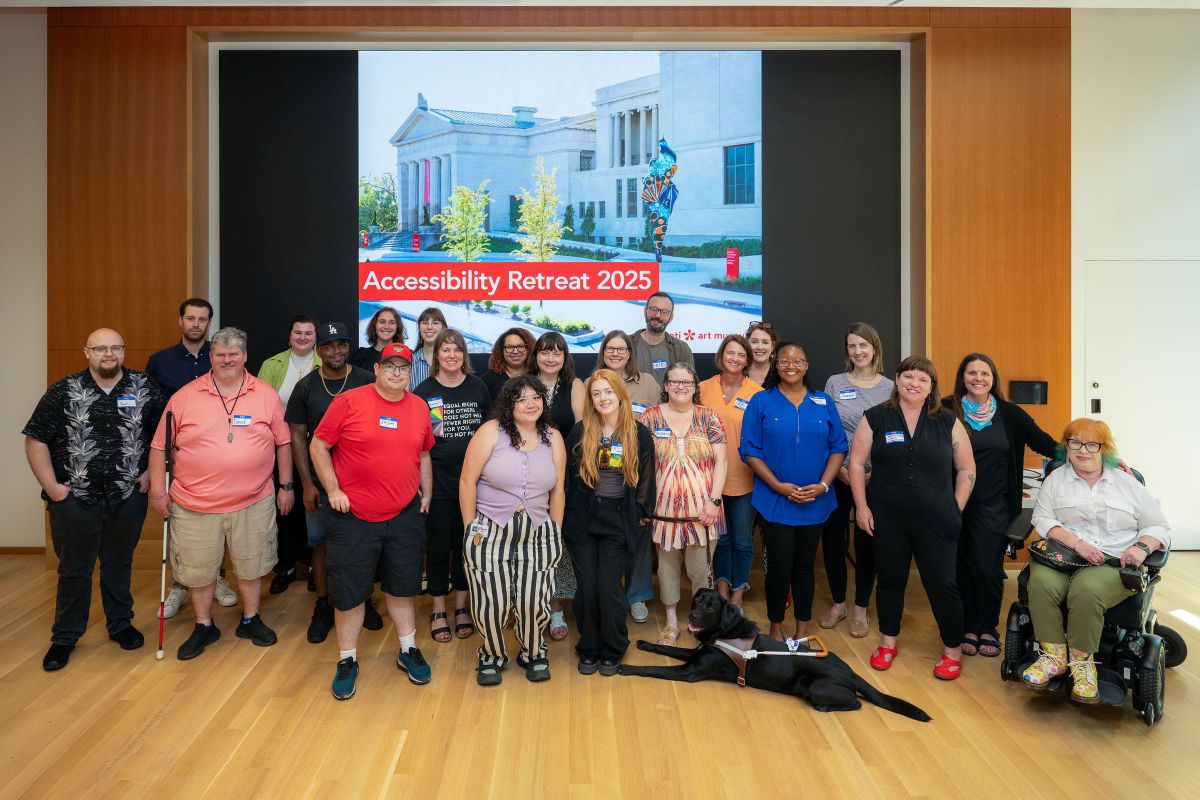- Events & Programs Home
- Calendar
- Accessibility
- Adults
-
Families & Teens
- Families & Teens Home
- 10x10 Teen Art Expo
- Art on the Rise
- Art Together: Art Making for Families with Children Ages 3–5
- Babies Sing with May Festival Minis
- Boy Scouts / Girl Scouts
- CAM Kids Day
- Family Storytime and Gallery Walk
- Family Studio: Art Making for Families with Children Ages 6–12
- Games in the Galleries
- Members-Only Baby Tours
- Public Baby Tours
- REC Reads
- Rosenthal Education Center (REC)
- Saturday Morning Art Class
- See Play Learn Kits
- Summer Camp
- Teen Fest: Zine and Comic Exchange
- RECreate
- Teachers
- Community Outreach
- Fundraisers
- Plan Your Own Event

- Events & Programs Home
- Calendar
- Accessibility
- Adults
-
Families & Teens
- Families & Teens Home
- 10x10 Teen Art Expo
- Art on the Rise
- Art Together: Art Making for Families with Children Ages 3–5
- Babies Sing with May Festival Minis
- Boy Scouts / Girl Scouts
- CAM Kids Day
- Family Storytime and Gallery Walk
- Family Studio: Art Making for Families with Children Ages 6–12
- Games in the Galleries
- Members-Only Baby Tours
- Public Baby Tours
- REC Reads
- Rosenthal Education Center (REC)
- Saturday Morning Art Class
- See Play Learn Kits
- Summer Camp
- Teen Fest: Zine and Comic Exchange
- RECreate
- Teachers
- Community Outreach
- Fundraisers
- Plan Your Own Event
Blog: CAM Uncovered
Blog: CAM Uncovered
- Home
- Plan Your Visit
- Art
-
Events & Programs
- Events & Programs Home
- Calendar
- Accessibility
- Adults
-
Families & Teens
- Families & Teens Home
- 10x10 Teen Art Expo
- Art on the Rise
- Art Together: Art Making for Families with Children Ages 3–5
- Babies Sing with May Festival Minis
- Boy Scouts / Girl Scouts
- CAM Kids Day
- Family Storytime and Gallery Walk
- Family Studio: Art Making for Families with Children Ages 6–12
- Games in the Galleries
- Members-Only Baby Tours
- Public Baby Tours
- REC Reads
- Rosenthal Education Center (REC)
- Saturday Morning Art Class
- See Play Learn Kits
- Summer Camp
- Teen Fest: Zine and Comic Exchange
- RECreate
- Teachers
- Community Outreach
- Fundraisers
- Plan Your Own Event
- Give & Join
- About
- Tickets
- Calendar
- Exhibitions
- Collections
- Blog
- Shop
Making 3D Prints Part of the Museum Experience
by Samuel Foulkes, Director of Braille Production and Accessible Innovation, Clovernook Center for the Blind and Visually Impaired
5/8/2024
accessibility , Accessible Expressions Ohio , 3D printing , Clovernook Center for the Blind and Visually Impaired , tactiles
Sunday, May 12, is the final day to see Accessible Expressions Ohio, the statewide art exhibition featuring Ohio artists, of all ages, with disabilities. Even members of the visually impaired community can experience “the most accessible and diverse art presentations ever displayed at the museum” with touchable 3D replicas of sculptures. Read on to discover how.
The Clovernook Center for the Blind and Visually Impaired created 3D-printed replicas of sculptures featured in the Cincinnati Art Museum’s Accessible Expressions Ohio exhibition. Six months earlier, Clovernook began working with museum curators and collections managers, to scan and print objects held in CAM’s collection. These included physical replicas of ancient Roman and Egyptian statues, 19th century African and European sculptures, and 3D contemporary art.
Our technicians utilized an Infrared (IR) 3D scanner and rotated the handheld device around each object to create a 3D digital file—this process typically takes five to ten minutes. The digital file then undergoes light editing and after is ready to be printed on a 3D printer!
The skills learned through these earlier sessions with CAM allowed us to then create accessible tactile resources for Accessible Expressions Ohio. We selected, scanned, and printed several objects—in front of an audience of CAM staff—to illustrate how this technology can be brought into the realm of artistic experience. Installation staff mounted the final touchable 3D pieces in the exhibition.
Through the eventual inclusion of tactile representations as an integral part of Accessible Expressions Ohio—and ideally future exhibitions—rather than available on request, Clovernook and CAM hope to provide a more independent cultural experience for visitors who are blind or have low vision.
Related Blog Posts


Cincinnati, OH 45202
Toll Free: 1 (877) 472-4226
Museum Hours
Museum Shop
Terrace Café
Library
Cincinnati Art Museum is supported by the tens of thousands of people who give generously to the annual ArtsWave Campaign, the region's primary source for arts funding.

Free general admission to the Cincinnati Art Museum is made possible by a gift from the Rosenthal Family Foundation. Exhibition pricing may vary. Parking at the Cincinnati Art Museum is free.
Generous support for our extended Thursday hours is provided by Art Bridges Foundation’s Access for All program.

General operating support provided by:






